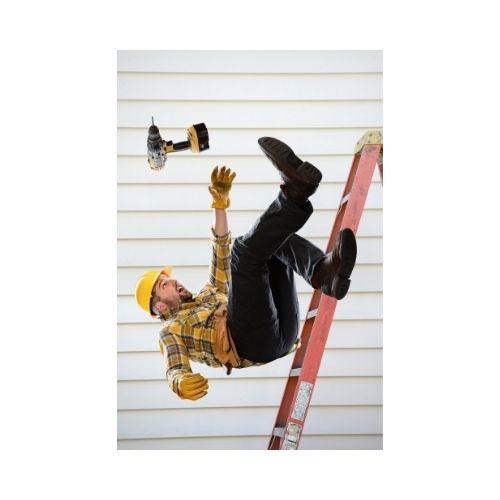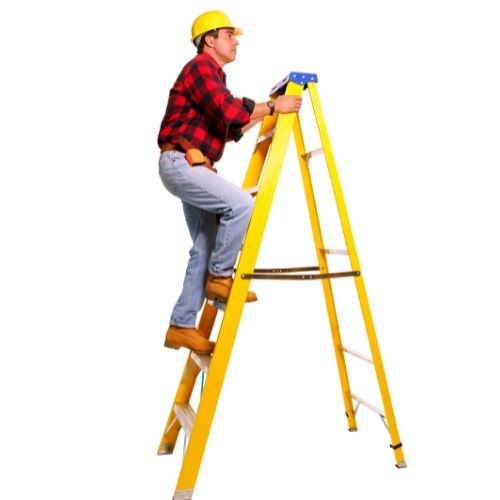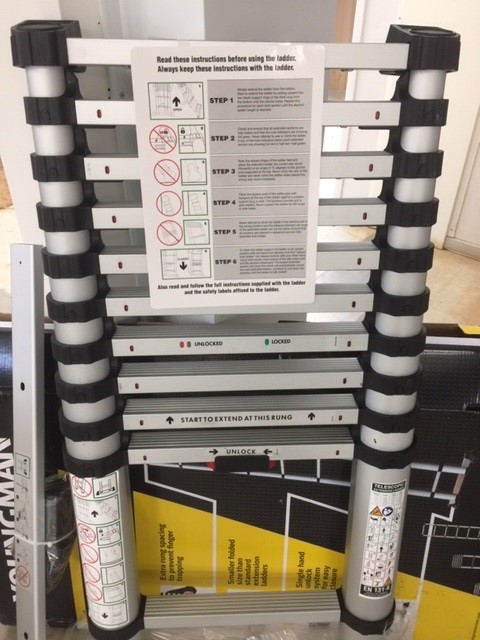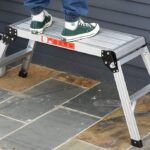Are ladders safe?
Ladders in general are safe to use as long as you follow some essential safety guidelines. If you don’t, ladder accidents can occur and there are ladder safety statistics showing that ladder injuries are on the rise. You can further read our article on Step Ladder FAQ’s here.

Ladders only become unsafe when they’re not used properly or if they’re defective.
You should always take care of your ladder, inspect it for damage before use and avoid standing on the top 2 steps unless it’s an emergency.
Ladders should also be placed on level, firm ground with their feet at the advisable distance from the wall they’ll be leaning against to minimize the risk of slipping from underneath them.
If a ladder is too long or wobbly once you stand on it, do not attempt climbing past the first couple of steps until you’ve fixed any stability problems.
This will help prevent falls from ladders. This is obviously even more prevalent at greater heights like cutting tall hedges. In fact, we have a great article on cutting tall hedges along with some solutions here.
When using a ladder , it’s also important to think about wearing a ladder safety belt or ladder safety harness in some situations.
This will help to keep you from falling off the ladder in case your grip slips and it will reduce the severity of ladder injuries should one occur.
In addition, you should have someone else on standby holding a ladder steady while you climb up or down it so that they can help prevent any ladder movement.
If any part of your ladder is defective, do not attempt climbing on it – replace the ladder instead for greater ladder safety.
Ladder accidents can be reduced or prevented by carrying out basic ladders skills and following the manufacturers guidelines.

The Combination stair ladder!
The combination stair ladder not only has the flexibility to adjust to suit your stair type, it’s combination types are perfect for all those inside and outside jobs!
How many points of contact on a ladder?
When using a ladder, it is advised that 3 points of contact are maintained at all times.
This means that the user must use 3 limbs on the ladder stile or ladder rung to secure themselves and to maintain balance and avoid any accidents. These in most cases are 2 feet and one hand.

Typically, some people feel comfortable with 2 points on the ladder – one foot on one step and their other foot on another step.
This can lead to issues with maintaining stability however as soon as these contact points are released by the user.
For this reason it is recommended that more than two points are used when using a ladder for an extended period of time.
At times, two feet on a tread, leaning into the ladder will suffice as long as your feet are at least two rungs below the top of the ladder.
People should also be aware that their ladder should be fully in contact with the climbing surface such as the top and bottom ladder stile feet or stabiliser bottom bar.
Creating an unstable base or head for their ladder can cause a ladder to twist during ascent which could cause a loss of balance.
Ladder risk assessment
Ladder hazards and control measures
In the construction industry, most, if not all tasks should have their risks assessed. This obviously is called a Risk Assessment.
In reality, this is not going to happen in a domestic setting but it’s worth knowing the basic principles. A Risk Assessment will contain a list of Hazards and then Control Measures to either eliminate or reduce their risk.
The definitions go as follows: A hazard is something which has the potential to cause harm. A risk is the likelihood of that hazard being realised.
The control measure is what we put in place to reduce or eliminate the likelihood.
Typically, the main hazard will be the risk of a fall from height along with the associated severity of an injury. The likelihood would be moderate.
Mostly, an assessment would be Low, Medium or High. So if the likelihood of a hazard being realised is high and the severity of the injury is high, this would set off alarm bells when carrying out a risk assessment.
Typical control measures for ladders are ensuring the correct Class of ladder is used, ensuring the task duration time is minimised and the height isn’t excessive.
Sometimes a “Tool box talk” on the safe use of ladders is needed before use and a permit issued.
Click here to see the HSE ladder and step ladder guide.
How many rungs should you leave at the top of a ladder as a handhold?
A ladder should project at least a metre above where you step off because that is the advised minimum safety requirement and allows enough room for climbing up and down safely.
The ladder will provide a handhold for climbing up and down safely, but if it is any lower, the user may put their foot on the ladder by accident when they climb up or down.
If the ladder has been outside in bad weather it could be even more slippery so you might want to add some extra rungs as a handhold.
What is the 4 to 1 rule when using a ladder?
The 4 to 1 rule relates to the distance the base of a ladder should be from the rest point at the top. If for example, and ease of understanding, the ladder is 4 metres long, the base of the ladder should be 1 metre out.
What makes a ladder unsafe?
A ladder is not intrinsically “unsafe”, it is just a piece of equipment just like any other that can be used incorrectly.
A ladder of a “step ladder” type should always be fully opened out to get the best balance and have its stay arms fully engaged or locked. Not following these guidelines can lead to trouble.
Any piece of access equipment in fact that comprises of foldable legs and locking mechanisms must be fully engaged.
Ladders need to be held with a firm grip at the top and bottom. Climbing a step ladder by just walking up it not holding on can also be dangerous.
It is also advisable not to use the whole ladder and not to use the top two steps as this will cause instability.
The ladder should be placed on level and firm ground which is dry, not soft ground that may give way when weight is applied. The ladder’s feet should also be able grip into this surface preventing slippage.

Presenting, The Telescopic Ladder
The ingenious Telescopic ladder could be the only ladder you’d ever need. Easy to store, use inside and outside and easy to transport!
Can I lean a ladder against a gutter?

There are a number of reasons why you shouldn’t lean a ladder against a gutter. These are some of the most important reasons.
One reason that it’s not safe to lean ladders against guttering is that plastic guttering can flex and deform.
This can cause a ladder to lean or twist and consequently slip sideways.
This means your ladder could fall over and injure both you and anyone around you as well as damaging property such as your house or even other people’s property if they happen to be below where it falls from.
The safest position for the top of a ladder is against a solid wall that has a rough surface so it resists a sideways movement. The ultimate safe way is to use a ladder stand off.
You can read our article on ladder standoff brackets here.
Can you store ladders outside?
You can store ladders outside but there are some things to consider. For example, you must protect the ladder against long term exposure to sun and moisture. This can obviously rot timber and cause corrosion to metals.
Plastic parts that aren’t UV resistant may also go brittle and snap after being exposed to the elements for a length of time.
Most larger ladders tend to be made from aluminium to reduce their weight and this makes them quite weather resistant.
Be mindful to inspect ladders before use as some left outside may have mild steel components that could rust over time and cause weakness or failure in load bearing parts.
Should ladders be inspected?
A ladder should always be visually inspected before every use. Visual ladder inspections can prevent some pretty serious ladder accidents from occurring as they will highlight any component failures or weaknesses that may cause a collapse under load.
Surprisingly, even the most experienced of people can fall off ladders and cause themselves terrible injuries. A simple ladder inspection and use of ladder safety precautions will help to ensure ladder accidents are reduced.
Most ladder accidents are preventable with a simple visual ladder inspection before every use. Check for damaged or corroded parts and that any safety features are working properly.
Should I buy a ladder?
The simple answer is yes. A ladder is an essential piece of kit to have around the home. For most people, a ladder is not used every day but it is something that you will hopefully use several times a year and kick yourself when a task arises and you don’t have one!
Ladders are useful for lots of household jobs including hanging curtains, painting, changing light bulbs and fixing shelves.
With many of these tasks you will need two free hands to safely complete them, so you really do need a ladder rather than reaching up with one hand.
Typically on the step ladder while holding onto the curtain rail with another so be sure to get the correct ladder for your task or at least go for a multi purpose one.
Visualise yourself carrying out a task and what you would do if you momentarily lost your balance…..would your ladders have something for you to grab?
The ladder you need depends on how high up you need to go and as just mentioned, how many hands you’ll need.
If it is just a couple of feet then a ladder stool will do the job but if your ceilings are higher or there are several steps in between you may need an extension ladder.
Before buying make sure it fits your ceiling height, also check that you can open and close it easily when at full length.
For domestic purposes ladders are generally made from either wood or aluminium because these materials are lightweight but strong enough to take your weight plus the tools and equipment that you have with you.
If working outside then be sure to get a ladder that has been manufactured especially for this purpose.
Should I buy a fire escape ladder?
If you live in a tall house or a communal type high rise apartment, it would definitely be a good idea to look into buying a fire escape ladder. They are easy to use, affordable and will always be there when you need it.

You would never regret buying one. However, some people still do not own one because of certain considerations.
For example, why buy fire escape ladder? What if I don’t need it? How much does it cost?
Will they be useful for me in the long run? These are some of the concerns that many people have before making a final decision on whether or not to invest in this item.
The most important decision to make is how you will get of of your home if you are trapped at a higher level, maybe because a stairway is inaccessible and you only have a window or balcony.
We recommend buying a fire escape ladder because there are many good reasons why you shouldn’t wait until the last minute when it could be too late.
Things to also consider are if you have very small children, or even pets that can’t climb a rope escape ladder. Think about a specialised basket with rope to lower your loved ones to safety.
You can read our article on fire escape rope ladders here.
Where to place a ladder when cleaning gutters?
We recommend that an extension ladder is not placed on a fascia board or the gutters themselves. This is because the ladders could slip or slide sideways on the fascia or the deformed plastic gutter.
The ladder should be against brickwork that will resist sideways movement and be most stable. Better still, the use of a ladder standoff bracket will give you increased stability at higher levels.
You can read our article on gutter cleaning here.






